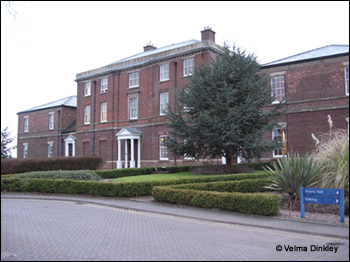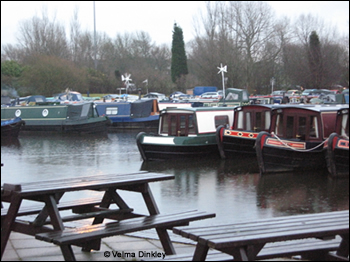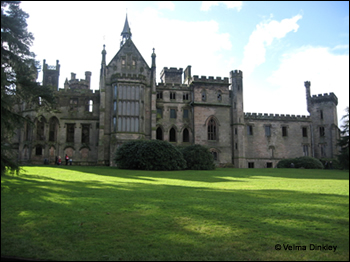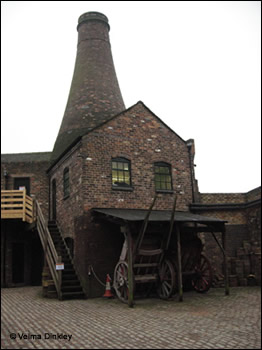As some Family Tree Forum members already know we took our two children (aged 8 and 6) to north Staffordshire for February half term, primarily for the purpose of a visit to the Alton Towers theme park, which had opened especially for the week.
Whilst I took my new laptop with us to keep up with events on FTF, I certainly had no intention of doing any family tree research, or for that matter, pursuing my interest in history… but little did I know, history was to pursue us during our four day visit.

We stayed in the four-star Best Western Moat House at Festival Park, Stoke on Trent – a modern, although most comfortable, hotel of uninspiring design. However, attached to it, via a corridor, was a much older building which was used for conferences. This was Etruria Hall, home of the the famous Wedgwood family up to 1840 when financial difficulties forced them to sell. In fact the whole area of Festival Park, or ‘Etruria’ as it was then known, was the home of the huge Wedgwood factory, employing thousands of local people up until 1950.
Josiah Wedgwood (1730-1795) paid £3000 for the site in 1767, with Etruria Hall designed and built by the architect Joseph Pickford between 1767-1771. Josiah was inspired by the artistic talents of the people of the Italian town of Etruria, and adopted this as the name for the area and his residence. His son, Thomas (1771-1805), is credited with the invention of photography at Etruria Hall in 1790.

on the Trent and Mersey Canal
The whole area, including the Shelton Bar Steelworks, was regenerated in the 1980s, culminating in the Garden Festival held in 1986 – hence the new name of ‘Festival Park’. Etruria Hall, which was renovated at the time, is the only building remaining from the Wedgwood era.
In fact the whole of this part of Staffordshire was known for its pottery production, due to the abundance of local coal and clay and was, and still is, known as ‘The Potteries’. It once had a skyline full of smoking bottle kilns, but only a very few now remain. Captain Edward J Smith of the ‘Titanic’ was born in nearby Hanley, at Well Street, in 1850, and attended the Etruria school. His father was a potter, whilst his mother ran a grocer’s shop. I wonder if the ‘Titanic ‘ would have suffered the same fate if Edward had followed his father’s trade, rather then take to the sea?
One of the last working potteries in the area is in Longton at the Gladstone Pottery Museum. Originally built in 1787, it wasn’t one of the most famous pottery producers in the area, but was one of the very few which were saved from demolition in the 1970s, when many faced the bulldozer. It’s a fascinating way of spending a few hours (and keeping the children amused) as you’re transported back to the world of a Victorian pottery. As well as displays of plates and other pieces of everyday crockery, the visitor is reminded that they also made sanitary ware and tiles in their ‘Flushed With Pride’ exhibition, complete with the sights and (not easily forgotten) smells of the Victorian slum.


Well, the children enjoyed their visit to Alton Towers, which was a 40 minute drive across the North Staffordshire moors. Thankfully they’re too young for the big ‘scary’ rides, and I don’t think I would want to go on with them anyway – perhaps I’m getting too old, preferring to keep my sea legs very firmly on solid ground.
Whilst Alton Towers is as commercialised as any theme park, right in front of you when you enter through the gates is the impressive ‘Alton Towers’ – the historic home of the Earls of Shrewsbury.
The estate dates from 1000BC when an Iron Age fort was built in the area. A castle was built soon after the Norman Conquest, although this was destroyed in the English Civil War of 1641-51. The building seen today dates from after this time and was originally a hunting lodge, with substantial improvements made to the house and grounds by the 15th Earl in the early 1800s. After his death in 1827, his work was continued by his nephew and then his nephew’s cousin, with work finishing in 1856.

The grounds were open to the public at certain times of the year from as early as 1839, and from the 1890s the 20th Earl started the tradition of summer fairs, where crowds would flock to see balloon festivals, firework displays, clowns and exhibitions of instruments of torture. By the 1920s it was in a state of neglect and decay, and was bought by a group of businessmen who set up the company ‘Alton Towers Ltd’ and ran it as a tourist attraction.
From the look of this Pathe Film clip of 1930 it was a beautiful and peaceful setting, ideal for a day of quiet relaxation, quite unlike what you would experience there today: ‘Fairy Fountains‘.
The army left the house and grounds in a derelict state after they requisitioned it during World War Two as an officer training centre. It did finally reopen in the 1950s, with the theme park as we know today starting life in 1980.
With such a fascinating history I welcomed the chance to enter this imposing building, and was drawn further and further into the darkness watching the tale of the curse of the chained oak on television screens. We were told that a fallen branch was recently uncovering during excavations and were led into a room with two pews either side with the branch as it’s centrepiece…
It was then that a safety bar came down in front of us, the staff made a swift exit through the doors from which we came and the lights were dimmed. We were swung backwards, so that we looked down at the people opposite us, and then forwards, so they looked down on us. As we continued to swing the lights went out, and from the feeling of G-forces on my body I feel sure that we rotated a full 360 degrees.
As I stumbled off the ride with my body feeling like jelly, slowly acclimatising to solid ground, my children excitedly requested another go, for which I politely refused. My obsession with the past had somewhat clouded my judgment in the present, and I had forgotten to check out the suitability of the theme park’s attractions whilst I’d been busy Googling the history of the area.
However, I’m certainly pleased that we did uncover history on our travels. Originally intended as a child-centred break, the historical aspect gave the children experiences which they would never have had in our leafy home county of Berkshire. Whilst we have no ancestors from the area, we found its pottery heritage particularly fascinating. The children enjoyed their very own hands-on experience at the Gladstone Pottery Museum by making their own mementoes of their visit – something which I’m sure they’ll treasure more than the memory of the thrills and spills of a theme park ride.
Velma Dinkley
© Velma Dinkley 2010